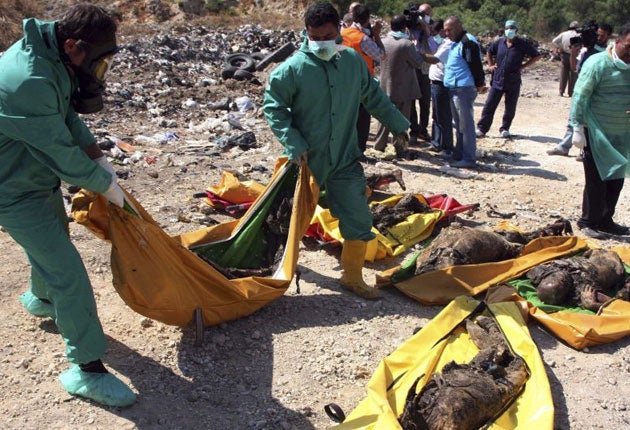Robert Fisk: We can't tell the victims to leave mass graves in peace


The Syrians say they discovered a mass grave this week containing the bodies of murdered soldiers outside a town called Jisr al-Shughour. "Armed gangs" are to blame, according to Syrian state television.
Well, maybe. Or perhaps they were killed by their colleagues for refusing to open fire on unarmed anti-Assad demonstrators. But all the world's a mass grave. Why, only a few miles north of Jisr al-Shughour, the Syrian fields are still strewn with thousands of bones and bits of skulls; all that is left in just this one location of the one and a half million men, women and children who were murdered in the 1915 Armenian holocaust. Then there's there's a place called "Barbara's Pit" near a town called Lasko where the mass grave, only 66 years old this time, contains perhaps 1,000 skeletons about whom no one really wishes to talk.
The investigation has been going on for two years now, a darkly political, deeply fearful inquiry because this mass grave is in Slovenia and contains the victims of Tito's victorious partisans, the pro-Nazi Croat Ustashe militia and their families, anti-communist Cossacks as well, perhaps, a few Hungarian collaborators no doubt, certainly some anti-Tito Serb Chetniks and their wives and fathers and brothers and children and nieces. Handed over to Tito's forces by us, the Brits, at the end of the Second World War, at the point of a bayonet; screaming with fear, they were, cutting their throats in the trains that took them back into Yugoslavia from the safety of Austria, women and children hurling themselves to their deaths off the carriages as they passed over river gorges.
We didn't want to have the communists infect Austria, you see. We wanted peace with Tito. Our own PoWs had to be returned to us. So we helped the killers to perpetrate the massacres that left perhaps 100,000 corpses rotting in the 600 mass graves of Slovenia. Most can never be identified, although Lljubljana's brave little government promises to dig up every one.
Some were, no doubt, war criminals, tools of the Nazis who ruled Croatia and gobbled up Bosnia and part of Serbia in 1941. There were extermination camps in the Ustashe's brutal "nation". But there are children's shoes in the mass graves and many of the bodies appear to have been executed naked. Women were among them. Small shoes still cover the lower part of femurs. The first writer to reveal the secrets of Barbarin rov, Roman Leljak, was charged by the police with "desecrating" a tomb. The real culprit – the head of the local mass murderers in 1945 – was a member of the First Slovene Division of Tito's "People's Defence". The slaughter lasted from May until September 1945, four months after Hitler's death, when even the Japanese war was over.
Mass graves are opened, I was told by a Serb colonel's wife during the Balkan wars, to pour more blood into them. But opening a few graves at Katyn – containing the corpses of thousands of Polish officers and intellectuals murdered by Stalin's NKVD, uncovered by the Nazis, denied by the Soviets and by the West for decades because it wanted to keep its relations with Stalin's butchers, until the new Russia itself told the truth – led to a strange new trust between Moscow and Warsaw with even ex-KGB man Putin bowing before the slaughter field.
Do these corpses matter now that most of their relatives – and their murderers – are dead? Memorialising individual deaths in war started only in 1914. Save for the glorious leaders, the Wellingtons and the Napoleons and the Nelsons, mass graves awaited all who fell in battle. The French dead of Waterloo were shipped off to England to be used as manure on the fields of Lincolnshire. If war is judicial murder, I suppose they suffered a crueller fate than the Chetniks and Cossacks and Ustashe and their families in 1945 whose graves are at least known even if their identities will always be anonymous.
Where we can, we do now identify the dead. The vast 1914-1918 war cemeteries and the graveyards of the Second World War define our craving for individualism amid barbarism. Yet mass graves lie beneath every crossroads in Europe; from the war of the Spanish succession to the Hundred Years War, to the Franco-Prussian war, from Drogheda to Srebrenica and, of course, to the ash pits of Auschwitz. In 1993, I visited the remains of the Treblinka extermination camp in Poland just after a gale had unearthed trees from the ground. In the roots of one, I found human teeth. Known unto God.
There's a mass grave only two miles from my home in Beirut – of Palestinian victims of the Sabra and Shatila massacre whom I watched being buried, only a few of whose names I know – and which will never be reopened. Not in our lifetime. And there are mass graves – of perhaps 30,000 Iraqi dead – buried alive by US forces in the 1991 Gulf War, unmarked, of course.
I'm not sure where the search should end. Who would deny the relatives of the dead of Srebrenica – whose principal killer at last resides in the Hague – the chance of praying at the graves? Who would turn their backs on the mass graves of Buchenwald? Or the frozen hills of bones that mark the burial of the 350,000 Leningraders who starved to death in 1941 and 1942?
I am reminded of that great American poet, Carl Sandburg. "Pile the bodies high at Austerlitz and Waterloo," he wrote. "And pile them high at Gettysburg/And pile them high at Ypres and Verdun./Shovel them under and let me work... I am the grass,/Let me work."
Join our commenting forum
Join thought-provoking conversations, follow other Independent readers and see their replies
Comments
Bookmark popover
Removed from bookmarks